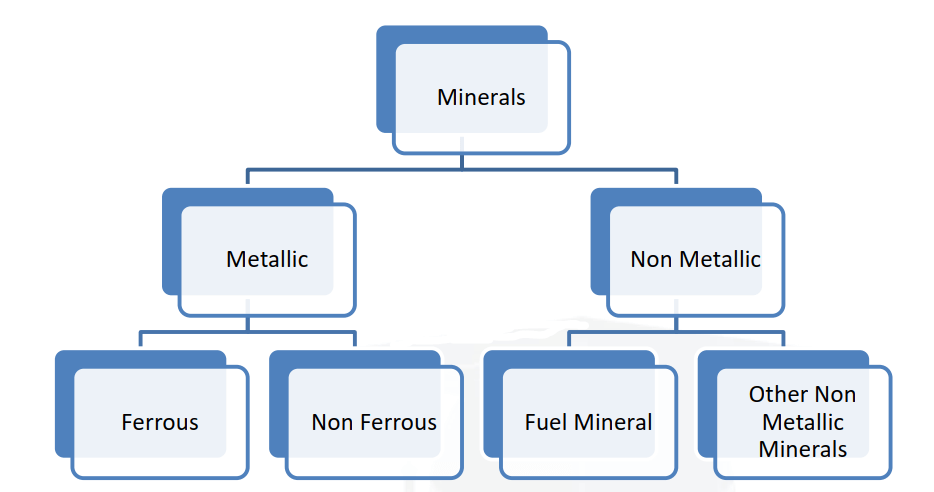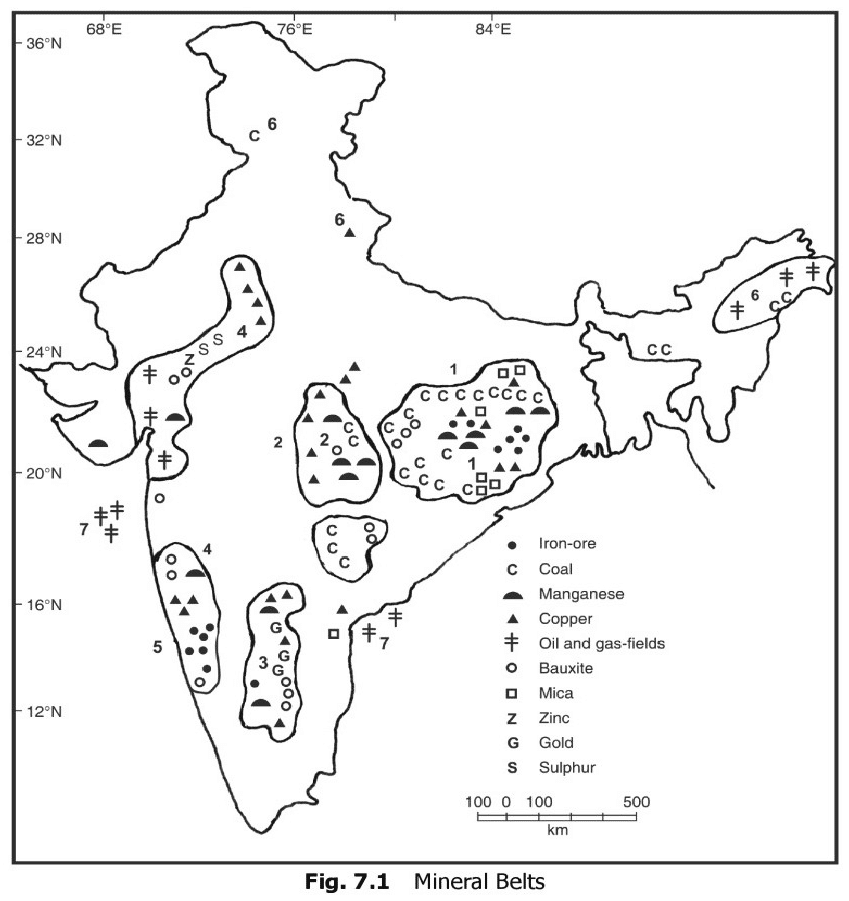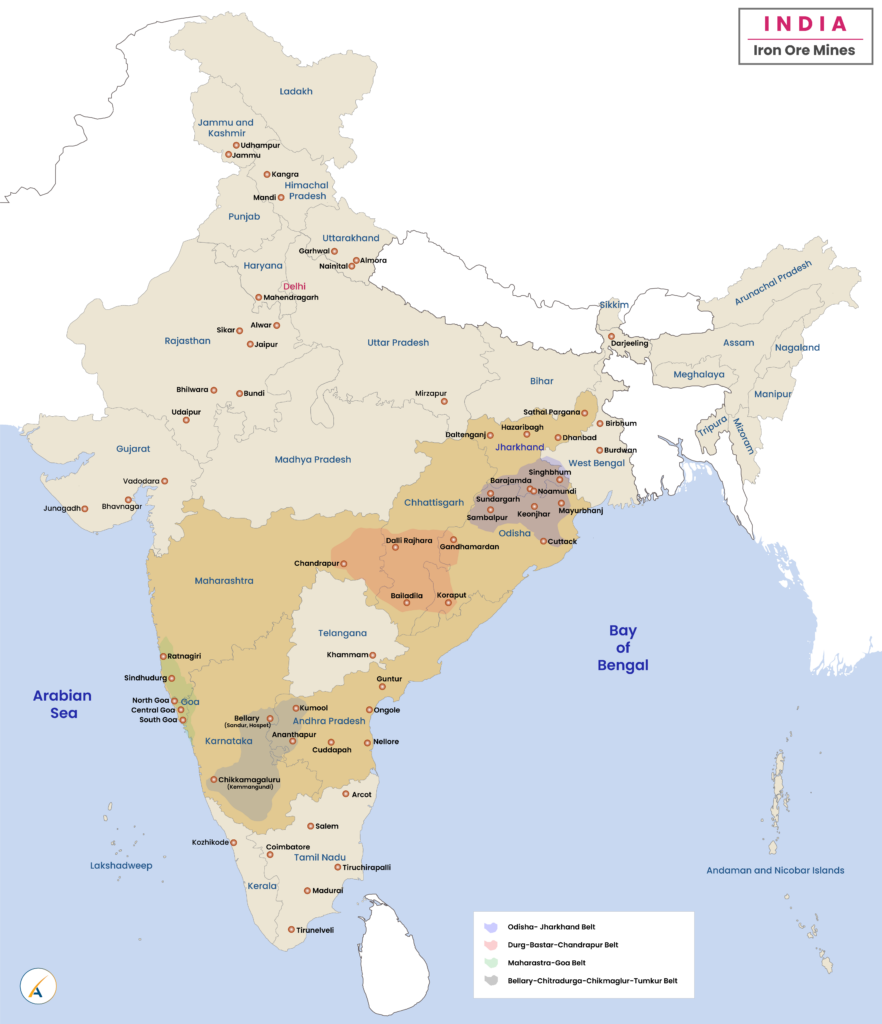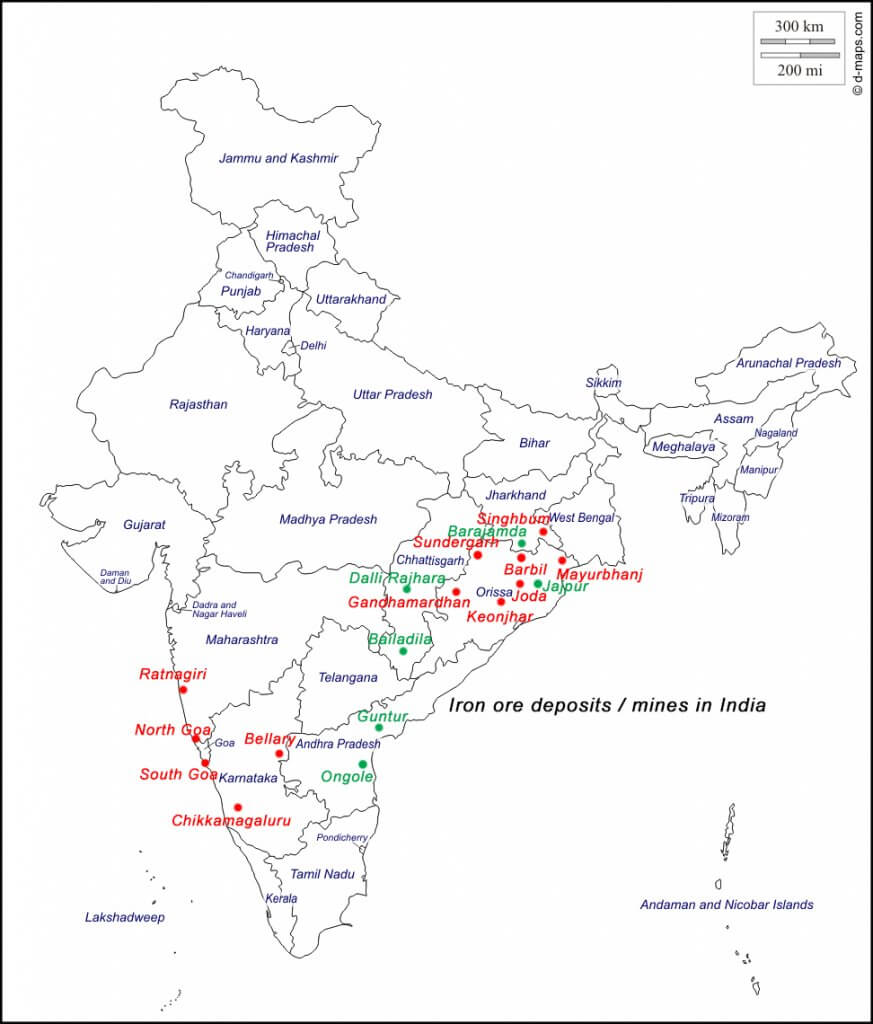Mineral Resources
A mineral is a naturally occurring substance, representable by a chemical formula, that is usually solid and inorganic, and has a crystal structure.
More than two thousand minerals have been identified and most of these are inorganic, which are formed by the various combination of elements. However, a small proportion of the earth’s crust contains organic materials, consist of single elements such as gold, silver, diamond, and sulfur.

Mineral resources can be divided into two major categories.
- Metallic Mineral Resources
- Non-metallic Mineral Resources
Metallic Minerals
- Metallic Minerals are minerals in which metal elements are present in their raw form. When metallic minerals are melted a new product is formed.
- Metallic minerals constitute the second most important group of minerals after fossil fuels. They are reserved in Archean rocks.
- Major examples of metallic minerals are iron ore, copper, gold, Zink, Silver, Manganese, Chromites, etc. They constitute 7% of the total mineral value in India.
- These minerals provide a strong base for the development of the metallurgical industry, and thereby help the process of industrialization and urbanization. India has a substantial reserve of these minerals.
- Metallic minerals are further sub-divided as ferrous and non-ferrous metallic minerals
- The minerals containing iron are known as ferrous (Chromites, Iron ore, and manganese), and without iron are known as non-ferrous (lead, silver, gold, copper, bauxite, etc.).
- Significance of Metallic Mineral:
- the standard of living of the people living in a country is judged by the consumption of iron. It is the backbone of modern civilization and the foundation of basic industry.
Non-metallic Minerals
- Non-metallic minerals do not contain any metal substances in them. Nonmetallic minerals are a special group of chemical elements from which no new product can be generated if they are melted.
- Depending upon the origination, non-metallic minerals are either organic (such as fossil fuels also known as mineral fuels, which are derived from the buried animal and plant, e.g. such as coal and petroleum), or inorganic minerals, such as mica, limestone, graphite, etc.
| Metallic | Non-Metallic |
|---|---|
| Metallic Minerals are minerals in which metal elements are present in their raw form. | Non-metallic minerals do not contain any metal substances in them. |
| When metallic minerals are melted a new product is formed. | In the case of non-metallic minerals, you don’t get any new product after such a process. |
| Metallic minerals are usually found in igneous and metamorphic rock formations. | Non-metallic minerals are often found embedded in young fold mountains and sedimentary rocks. |
| Metallic minerals are good conductors of electricity as well as heat. | Non-metallic minerals are basically good insulators of electricity and heat. |
| Metallic minerals have high malleability and ductility. | Non-metallic minerals, lack in malleability and ductility, and these minerals break down easily. |
| Metallic minerals generally have lustre. | Non-metallic minerals do not have any shine or lustre. |
Mineral Resources in India (Mineral Rich Regions)
There are five major mineral belts in India namely:
- Northern Belt
- Central Belt
- Southern Eastern region
- South Western region
- North-Western region
Northern Belt: The Northern Belt comprise of the following regions-
- Chhota Nagpur plateau:
- Minerals found in this region is Kynite(100%), Iron (90%), Chromium(90%), Mica(75%), Coal(70%).
- Manganese, copper, and limestone are some other minerals found in this region.
- Assam Petroleum reserve: This region comprises the reserves of petroleum and lignite coal, tertiary coal, etc.
Central belt:
- This region comprises the Chhattisgarh and Maharashtra region which is the extension of the Chhota Nagpur plateau.
- There are huge reserves of Iron and limestone in Chhattisgarh.
- Godavari-Wardha valley with huge coal reserves lies in this region.
South Eastern region
- Eastern Karnataka: In this region, Bellary and Hospet are known for their iron reserves
- Andhra Pradesh: Cuddapa and Kurnool region are major mining centres. Nellore in Andhra Pradesh is known for Mica reserves.
- Telangana: Telangana is known for Bauxite reserves.
- Tamil Nadu: Tamil Nadu has the highest lignite coal reserves in India.
South Western region
- Karnataka:Dharwad region of Karnataka is known for its high mineral reserves.
- Shimoga, Chitradurg, Yumkur, Chikmaglur are some other areas with high mineral reserves.
- Goa is known for its rich iron reserves.
- Ratnagiri in Maharashtra also has iron reserves.
North Western region
- This region consists of the areas Rajasthan and Gujarat along the Aravalli Range.
- Gujarat is known for its petroleum deposits. Gujarat and Rajasthan both have rich sources of salt.
- Example: Salt from Kutchh and Playa Lake of Rajasthan.
- Rajasthan is rich in building stones i.e. sandstone, granite, marble. Gypsum and Fullers earth deposits are also extensive. Dolomite and limestone provide raw materials for the cement industry.

Iron Ore Distribution in India
Iron Ore
- Iron ores are rocks and minerals from which metallic iron can be extracted.
- India has large iron ore reserves. It occurs in various geological formations but major economic deposits are found in volcano-sedimentary Banded Iron Formation (BIF) from the Precambrian age.
- Magnetite is the finest iron ore with a very high content of iron up to 72 percent. It has excellent magnetic qualities, especially valuable in the electrical industry.
- Hematite ore is the most important industrial iron ore in terms of the quantity used but has a slightly lower iron content than magnetite.
- The highest producer is the Odisha Jharkhand belt, Durg Bastar Chandrapur belt, Bellary-Chitradurga-Chikmagalur-Tumkur belt, and the Maharashtra Goa belt.
The iron ore is found in following four type:
- Magnetite: It is the most important and best kind of iron ore. It contains about 72 percent metallic iron in it. It is found in Karnataka, Andhra Pradesh, Rajasthan, Tamil Nadu, Goa and Kerala.
- Hematite: It is also an important source of Iron. It contains about 60-70 percent metallic iron in it. It is red and brown in colour. It is found in Odisha, Jharkhand, Chhattisgarh and Andhra Pradesh. In the western section, Karnataka, Maharashtra and Goa have this kind of ore.
- Limonite: It contains about 30 to 40 percent metallic iron in it. It is mostly yellow in colour. It is low-grade iron ore.
- Siderite: It has more impurities. It contains about 48 percent metallic iron content in it. It is brown in colour. It contains a mixture of iron and carbon. It is low-grade iron ore. It is self-fluxing due to the presence of lime.
Iron Ore Distribution and Reserves
About 95% of total reserves of iron ore is found in the States of Odisha, Jharkhand, Chhattisgarh, Karnataka, Goa, Telangana, Andhra Pradesh, and Tamil Nadu.

Iron Ore in Karnataka – Here Iron ore is mainly Mined in:
- Chikmagalur District – In Chikmagalur District high-grade iron ore deposits are those of Kemmangundi in Baba Budan Hills (Supply Iron ore to Bhadravati steel plant). On the other hand, the Kudremukh Hills in Chikmagalur District have very large deposits, but they consist of low-grade Magnetite.
- At Kudremukh iron ore is mined on large scale for export, which is exported from New Mangalore port.
- Bellary-Hospet area and Sandur Ranges have deposits of high grade. (Iron ore of this area serves the Vijaynagar steel plant at Hospet.)
- Iron ores are widely distributed in the state, but high-grade ore deposits are those of Kemmangundi in Bababudan hills of Chikmagalur district and Sandur and Hospet in Bellary district (a lot of mining mafias). Most of the ores are high-grade haematite and magnetite.
- Other mining areas in Karnataka are Chitradurga, Uttar Kannad, Shimaga, Dharwad, Tumkur, Kumaraswamy, and Ramandurg, etc.
- Donimalai Iron Ore Mine
- Commissioned in 1977, the mine is located in Bellary region of Karnataka.
- It produces 4 million tonnes of Run of Mine (“ROM” means ore in its natural, unprocessed state) ore per year.
- The average grade of ore extracted has 65% Iron.
- Port of Export
- Chennai outer harbour, TamilNadu: linked by 532km Rail
- Marmagao Port, Goa: linked by 370 km Rail
- It is being mined by the National Mineral Development Corporation (NMDC).
- Recently, for a short period, NMDC stopped its operation because the state government imposed an 80% premium on the iron ore sales from the mine.
- But now lease has been extended for the next 20 years for NMDC and NMDC is resuming its operations.
Iron Ore in Orissa –
- The ores in Orissa are rich in Hematite. India’s richest Hematite deposits are located in Barabil-Koira Valley. This valley lies in Keonjhar and adjoining Sundergarh district.
- The most important deposits occur in:
- Keonjhar
- Sundargarh
- Mayurbhanj
- Koraput
- Cuttack
- Sambalpur
Iron Ore in Chhattisgarh –
- Chhattisgarh has about 18 percent of the total iron ore reserves of India.
- The iron ores are widely distributed, the prominent deposits being those of Bastar and Durg districts. Bailadila in Bastar district and Dalli Rajhara in Durg district are important producers.
- Bailadila mine is the largest mechanized mine in Asia (Ore beneficiation only done here).
- A 270 km long slurry (a semi-liquid mixture) pipeline is being constructed to bring the ore from the Bailadila pithead to the Vizag plant. Smelting is done in Vizag (Vishakhapatnam) Iron and Steel plant.
- Bailadila produces high-grade ore which is exported through Vishakhapatnam to Japan (there is no iron ore in Japan, but the market is huge due to the Automobile industry) and other countries where it is in great demand.
- The Dalli-Rajhara range is 32 km long with significant iron ore reserves with ferrous content of 68 to 69 percent.

Iron Ore in Goa –
- Production of iron ore in Goa started quite late and it is a recent development.
- Goa now produces over 18 percent of the total production of India. There are nearly 315 mines in North Goa, Central Goa, and South Goa.
- The richest ore deposits are located in North Goa. These areas have the advantage of river transport (through river Mandovi and Zuari connect through Cumberjua canal) or ropeways for local transport and that of Marmagao port for exporting the ore.
- Most of Goa’s iron ore is exported to Japan.
Iron Ore in Jharkhand –
- Jharkhand accounts for 25 percent of reserves and over 14 percent of the total iron ore production of the country. Iron ore mining, first of all, started in the Singhbhum district in 1904 (then a part of Bihar).
- Iron ore of the Singhbhum district is of the highest quality and will last for hundreds of years.
- The main iron-bearing belt forms a range about 50 km long extending from near Gua to Pantha in Bonai (Orissa). The other deposits in Singhbhum include those of Budhu Buru, Kotamati Burn, and Rajori Buru.
- The well-known Noamandi mines are situated at Kotamati Buru. Magnetite ores occur near Daltenganj in the Palamu district.
- Less important magnetite deposits have been found in Santhal Parganas, Hazaribagh, Dhanbad, and Ranchi districts.
Iron ore in Other States –
- Apart from the major producing states described above, iron ore in small quantities is produced in some other states also. They include :
- Andhra Pradesh (1.02%): Kumool, Guntur, Cuddapah, Ananthapur, Khammam, Nellore
- Maharashtra (0.88%): Chandrapur, Ratnagiri, and Sindhudurg
- Madhya Pradesh (0.66%)
- Tamil Nadu: Salem, North Arcot Ambedkar, Tiruchirapalli, Coimbatore, Madurai, Nellai Kattabomman (Tirunelveli)
- Rajasthan: Jaipur, Udaipur, Alwar, Sikar, Bundi, Bhilwara
- Uttar Pradesh: Mirzapur
- Uttaranchal: Garhwal, Almora, Nainital
- Himachal Pradesh: Kangra and Mandi
- Haryana: Mahendragarh
- West Bengal: Burdwan, Birbhum, Darjeeling
- Jammu and Kashmir: Udhampur and Jammu
- Gujarat: Bhavnagar, Junagadh, Vadodara
- Kerala: Kozhikode.
Ministry of Mines Annual Report 2019-20
As per this report:
- India is self-sufficient in Bauxite, Iron Ore and Sillimanite. Magnesite, Rock Phosphate, Manganese and Copper concentrate are the ones which are imported in India.
- Now that the mines in Odisha are functional, India can even export iron ore.
- India’s leading state that produces iron ore is Odisha. It accounts for more than 55% of the total production followed by Chhattisgarh producing almost 17%, this is followed by Karnataka and Jharkhand producing 14% and 11% respectively.
- In India, the value of metallic minerals in 2018-19 was at INR 64,044 crores. Among these the principal metallic minerals, iron ore contributed more than 45000 crore rupees. This was equivalent to 70% of the contribution.
Export of iron ore from India
- India is the fifth largest exporter of iron ore in the world. We export about 50 to 60 percent of our total iron ore production to countries like Japan, Korea, European countries, and lately to Gulf countries.
- Japan is the biggest buyer of Indian iron ore accounting for about three-fourths of our total exports.
- Major ports handling iron ore export are Vishakhapatnam, Paradip, Marmagao, and Mangalore.
Problem faced by iron ore mining industry in India
- India’s iron ore mining face a lot of problems, some of them are:
- Lack of adequate mechanization
- Infrastructure
- Financial Resources
- Human Resources
- Environmental Concerns
- Export orientation
- Trade Policy
- Global Economic Slowdown
- Many of them are found in few states only.

I don’t know who are you and how you are able to make a profit from this but I should thank you from the bottom of my heart sir.
such detailed notes and well-written
thankyou sir thank you soo much
I have gone through all of the resources and I find it really soo helpful sir thankyou
I don’t make any profit from this website instead I have invested all my affiliate + ebook income + my savings to this website to help UPSC aspirants who can’t afford coaching or don’t want to join any coaching. I thought UPSC aspirants will support this website but, very few people are supporting it and unfortunately, It is becoming unsustainable for me to run this website. Let’s see how long I can run this website.
you should charge atleast a token fee of 500 rs atleast … just to ensure value of labour as well as value for resource.
True
Sir, kindly add a token amount who are willing to contribute now! Once selected will definitely contribute in some kind!
tell us how can we contribute sir
great initiative shouldn’t stop in the way sir
we are ready to contribute
Thanks 😊 sir for providing wonderful content…. please provide your UPI I’d…so that anyone who wants to send you money can send..thanks again you are just amazing no one provide content like yours
yes sir …keep the good work … pls tell how we can contribute..thanks
sir please tell us how we can support by financially sir please provide any link
Support by downloading any Notes on LotusArise Store.
https://store.lotusarise.com
You have to run this website Sir.It is helping us alot.Thank you
Guys, Even 1% people of total visitors are not contributing when everything is available for free!
Sir, you are truly saying Good but here is a fact, We are students, some of us are from poor background and some of us belongs to Average financially well living family background
It’s our pleasure to have your benevolent support ♥️
We are truly helpful to you..
And we will surely purchase your other notes as well if we need..
Now lastly, I want to say, We are really thankful to you for your work
It is free, Just because of you, Your free content proves that In our country not salable, Knowledge is not for sale…
Thanks You & Love from Uttar Pradesh 🍫♥️
Thank you so much 🙏
sir thank you so much.
There are only some people who helps the other selflessly. You are one of them sir. This site is really very helpful. Whenever i have any questions to answer or doubt, the first site that comes in my mind is lotusarise. I jump on this site without wasting my time because I know the things that I get here, will not get anywhere else. Thank you from the bottom of my heart and love u sir.
Thanks for your kind words. Keep reading & Happy Learning.
Sir plz tell us about urself
Thank you sir for providing a precious guideline to us
Thank you so much sir
Its really a great full work till now i also did not contribute but definetly contribute in future from my saving because now i am not earning thank you sir from bottom of my heart
Excellent job
I am preparing for the examination by self-study and have wasted a lot of time in finding the good resource for Geography and now found this site. All the topics are at one place and that too with very informative, well-presented content.
Thanks a lot for providing us such an excellent content!
Internet Surfing is the best hobby of every UPSC aspirant. Keep Reading.
Sir thank you so much for providing such information to us with out any charges .🙏🙏🙏🙏🙏🙏🙏🙏🙏🥰 I can see your hard work and dedication in these notes . again thank you so much sir ❤️
Sir Thank you so much for this website .
It helps not only understand the syllabus very easily but also a top quality notes are also available ..Really appreciating sir ❤️
V nyc
THANK YOU WORD IS EVEN SMALL FOR YOUR EXCELLENT CONTRIBUTION TO UPSC ASPIRANT , THIS SHOWS YOUR WILLINGNESS TO HELP NEEDY PEOPLE AT NO COSTS .
THANK YOU FOR HELPING STUDENTS LIKE ME WHO WANT CONSOLIDATE MATERIAL FOR Preparations.
Thank you sir for your kind gesture to help us for our preparation…it’s really very helpful…please go ahead…whole heartedly wishing for your great success and make more aspirants get benefitted like us🙏🙏
i do self study at home and this site helps at a very great extent in my preparation. thankyou so much sir this is really really helpfull . the best , detailed, simplify and excellent content.
i have no such word which can show how thankfull i am. thank you for your efforts sir. ☺
Keep Reading
Heartly TQ so much and Love you sir ❤️ 😍
Sir great explanation
thank you so much for the information, it’s really helpful for us, thank you thank you thank you very much.
Great content i must say… I don’t known who you are Sir, but this is an excellent initiative of yours… Perhaps you might have been one of the brightest aspirats… I have been using the contents of your site for the last 6-7 months.. Perhaps the best blogging on upsc geography I have ever read..thankful to u & your all hardworks… You should charge a minimum token fee
Thankq so much sir
Best quality iron ore is Hematite not Magnetite. Please rectify it.
Thanku so much sir …inti help ke liye.✨
Thankful to u sir, but sir I have need of medical history notes pls help me
Thanks you so much sir❤️